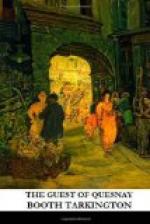The turpentine rag at least proved effective; I scoured away the last tokens of my failure with it, wishing that life were like the canvas and that men had knowledge of the right celestial turpentine. After that I cleaned my brushes, packed and shouldered my kit, and, with a final imprecation upon all sausage-sandwiches, took up my way once more to Les Trois Pigeons.
Presently I came upon an intersecting path where, on my previous excursions, I had always borne to the right; but this evening, thinking to discover a shorter cut, I went straight ahead. Striding along at a good gait and chanting sonorously, “On Linden when the sun was low,” I left the rougher boscages of the forest behind me and emerged, just at sunset, upon an orderly fringe of woodland where the ground was neat and unencumbered, and the trimmed trees stood at polite distances, bowing slightly to one another with small, well-bred rustlings.
The light was somewhere between gold and pink when I came into this lady’s boudoir of a grove. “Isar flowing rapidly” ceased its tumult abruptly, and Linden saw no sterner sight that evening: my voice and my feet stopped simultaneously—for I stood upon Quesnay ground.
Before me stretched a short broad avenue of turf, leading to the chateau gates. These stood open, a gravelled driveway climbing thence by easy stages between kempt shrubberies to the crest of the hill, where the gray roof and red chimney-pots of the chateau were glimpsed among the tree-tops. The slope was terraced with strips of flower-gardens and intervals of sward; and against the green of a rising lawn I marked the figure of a woman, pausing to bend over some flowering bush. The figure was too slender to be mistaken for that of the present chatelaine of Quesnay: in Miss Elizabeth’s regal amplitude there was never any hint of fragility. The lady upon the slope, then, I concluded, must be Madame d’Armand, the inspiration of Amedee’s “Monsieur has much to live for!”
Once more this day I indorsed that worthy man’s opinion, for, though I was too far distant to see clearly, I knew that roses trimmed Madame d’Armand’s white hat, and that she had passed me, no long time since, in the forest.
I took off my cap.
“I have the honour to salute you,” I said aloud. “I make my apologies for misbehaving with sandwiches and camp-stools in your presence, Madame d’Armand.”
Something in my own pronunciation of her name struck me as reminiscent: save for the prefix, it had sounded like “Harman,” as a Frenchman might pronounce it.
Foreign names involve the French in terrible difficulties. Hughes, an English friend of mine, has lived in France some five-and-thirty years without reconciling himself to being known as “Monsieur Ig.”
“Armand” might easily be Jean Ferret’s translation of “Harman.” Had he and Amedee in their admiration conferred the prefix because they considered it a plausible accompaniment to the lady’s gentle bearing? It was not impossible; it was, I concluded, very probable.




